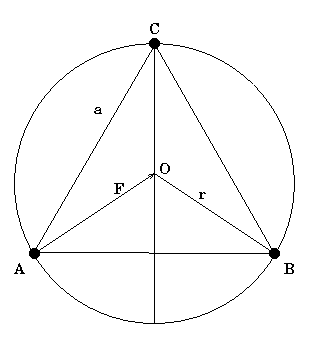| Example: Three stars, each of mass m = 97 x 1020 kg, are situated on the vertices of an equilateral triangle of side a = 2 x 103 km. The only force acting on them is the gravitational force. Due to some cosmic event, all the three stars are simultaneously set in motion. The three stars move in a circle, maintaining their original separation and configuration. Find:
- the velocity of each star; and
- the time period of the circular motion.
Solution: 
The situation is shown in the schematic diagram above with the three stars labeled A, B and C. Let each star attract the other by a force F'. Then The resultant force on any star, say A, is For the circle, the radius r is given by Assume star A is moving with velocity v. The centrifugal force is balanced by the gravitational force of attraction. A force balance on star A gives Thus, the velocity of each star is Substituting G = 6.67 x 10-11 N m2/kg2, m = 97 x 1020 kg and a = 2 x 106 m, the velocity v = 568.77 m/s.
b. The time period T of the circular motion is readily calculated from Substituting v = 568.77 m/s and r = 1.15 x 106 m, the time period T = 12.76 x 103 s.
|